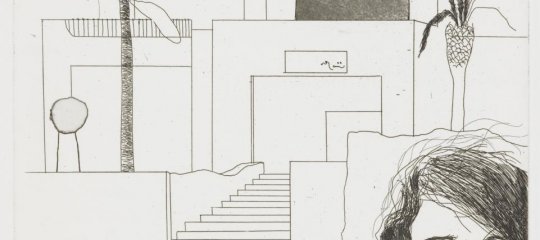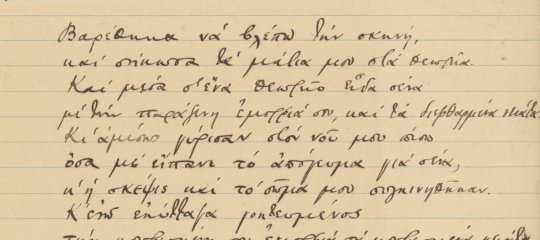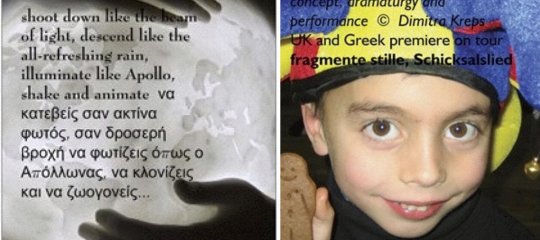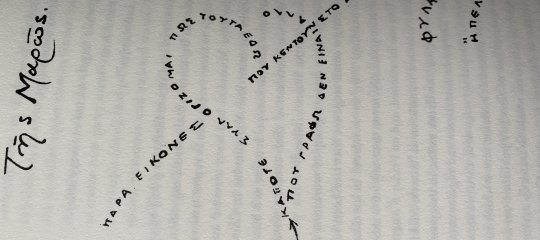Αρετή Πότσιου: Λίγος κινηματογράφος ίσως;
Λοιπόν, όπως συνήθως, ο συνάδελφος Τάσος με έβαλε σε νέο μπελά. Καλό μπελά, μα χρονοβόρο. Πώς; Με αυτό που είπε στο σχόλιό του, ότι γράφει τους διαλόγους από σκηνές ταινιών.
Καθώς ήθελα να δουν τα παιδιά στην τάξη τη «Στέλλα» του Κακογιάννη, και επειδή κουράζει και αποθαρρύνει να μην καταλαβαίνεις τι λένε και τι γίνεται στην ταινία, κατέγραψα το διάλογο στη σκηνή που ακολουθεί. Διαφορετικά δεν θα είχαν καταλάβει σχεδόν τίποτε.
Μέσα από την ταινία, είχαμε την ευκαιρία να πούμε δυο λόγια για τους συντελεστές της, αληθινά κοσμήματα, προσωπικότητες που εξέφρασαν την ελληνική ψυχή (όπως γράφει και η διαφημιστική αφίσα έξω από τον «Παράδεισο» στην ταινία) και διαμόρφωσαν την ελληνική πολιτιστική ταυτότητα στο δεύτερο μισό του εικοστού αιώνα.
Από την ταινία σκέφτομαι να δούμε ακόμη:
τη σκηνή με τον δυναμίτη
τη σκηνή με το θάνατο του Αλέκου (αρχίζει με την πύλη της Αθηνάς Αρχηγέτιδας, περιλαμβάνει την τραγική σκηνή του τέλους του άτυχου εραστή, την κηδεία στο Α΄ Νεκροταφείο, όπου προς στιγμήν διακρίνεται και ο τάφος του Σλήμαν, και τελειώνει με το τραγούδι που σκοτώνει, «Αγάπη που ’γινες δίκοπο μαχαίρι»)
τη σκηνή που, αντί για νύφη, κατεβαίνει η Μελίνα ντυμένη στα μαύρα και λέει πως δεν είναι γραμμόφωνο, για να την αλλάζουν
και, τέλος, την τελευταία περιβόητη σκηνή με το μαχαίρι, και με τους γείτονες να τρέχουν με νυχτικά και πιτζάμες, ενώ η Αννέτα σε υστερία κραυγάζει, αληθινός χορός τραγωδίας, γύρω από τον Μίλτο που κουβαλάει στα χέρια τη σκοτωμένη του αγάπη, νά, ξανά ζωντανεμένη η πρωταρχική τραγική ουσία της ανθρώπινης ύπαρξης, άλλοτε σε παλάτια, τώρα σε χαμοσόκακα και γειτονιές.
Αυτό που παρατήρησα μέχρι στιγμής είναι ότι οι φοιτητές αυτού του επιπέδου - αρχή δεύτερου χρόνου - όταν παρακολουθούν ταινία, μετά τη μισή ώρα κουράζονται, γι’ αυτό οι σκηνές πρέπει να είναι σύντομες και να επιλέγονται με φροντίδα. Το κείμενο, με το ύφος του της καθημερινής ομιλίας, τους δυσκολεύει αρκετά.
Ποια οφέλη θα προκύψουν τυχόν μακροπρόθεσμα, δεν είμαι σε θέση να εκτιμήσω από τώρα. Το ολοφάνερο και άμεσο αποτέλεσμα πάντως είναι πως, εγώ τουλάχιστον, βλέποντας και ξαναβλέποντας - με άλλο μάτι τώρα - τέτοια πράγματα, παθαίνω μια ζημιά. Μακάρι να την πάθουν και μερικοί ακόμη τέτοια ζημιά.
Φίλε μου Τάσο, σ’ ευχαριστώ για την ιδέα. Περιμένουμε κι άλλες.
Πες μου, πώς το δουλεύεις εσύ; Μη μ' αφήνεις να σκάω από περιέργεια, έστω κι αν μετά θα ζηλεύω (όπως, παρεμπιπτόντως, ζήλεψα και με το 9ο κεφάλαιο του βιβλίου σου, το τόσο ενδιαφέρον, κι ο λόγος να ρέει).
Μου λείπουν κι ένα σωρό πληροφορίες, πχ τηλεφώνησα στη μάνα μου, για να σιγουρευτώ ότι ο χορός είναι τσάμικος.
Μακάρι να ήμασταν κοντά και να δουλεύαμε μερικοί συνάδελφοι μαζί κι όχι ο καθένας μόνος του. Ας κάνουμε, λοιπόν, κάτι από αυτό το κουτί!
ΣΤΕΛΛΑ
Σκηνοθεσία και σενάριο: Μιχάλης Κακογιάννης
[Από το θεατρικό έργο «Η Στέλλα με τα κόκκινα γάντια», του Ιάκωβου Καμπανέλη.]
Παίζουν: Μελίνα Μερκούρη (Στέλλα)
Αλέκος Αλεξανδράκης (Αλέκος)
Γιώργος Φούντας (Μίλτος)
Ντεκόρ: Γιάννης Τσαρούχης
Μουσική: Μάνος Χατζηδάκις (στίχοι Μιχ. Κακογιάννη)
Βασίλης Τσιτσάνης
Συμμετέχει (παίζει και τραγουδάει): η Σοφία Βέμπο
Σκηνή στο κέντρο «Παράδεισος», μετά την αποτυχία με τον «προβολέα».
ΑΛΕΚΟΣ: Καλησπέρα. Μπορώ να προσφέρω τα συγχαρητήριά μου;
ΣΤΕΛΛΑ: Μα τώρα κοροϊδεύεις κι εσύ;
……………………………………………………………………………………
ΣΤΕΛΛΑ: Μωρέ θα οικονομήσω εγώ κανένα πιάνο, πού θα μου πάει;
ΜΑΡΙΑ: Κάνε λίγο υπομονή και θα σ’ το οικονομήσω εγώ, κούκλα μου.
ΣΤ: Δεν μπορώ να κάνω υπομονή, με ξέρεις εμένα.
ΜΑ:Σε ξέρω, πώς δε σε ξέρω! Μακάρι να ’χανε κι άλλες καρδιές σαν της Στέλλας. Έτσι δεν
είναι Αλέκο;
………………
ΑΛ: Ούτε καλησπέρα δεν μου ’πες.
ΣΤ: Άσ’ τα, μωρέ Αλέκο.
ΑΛ: Έλα τώρα, μην το παίρνεις τόσο τραγικά!
ΣΤ: Το παίρνω. Δεν είμαι Αννέτα εγώ…. Αλήθεια, τι σου ’λεγε εκεί πέρα;
ΑΛ: Δε βαριέσαι!
ΣΤ: Νομίζεις πως δεν ξέρω; Δεν είναι η πρώτη φορά. Μόλις μυριστεί πως μ’ αρέσει κάποιος,
πάει να μου τον φάει με τα νοικοκυριά. Άσε που λέει κι ένα σωρό ψευτιές.
ΑΛ: Στο βάθος όμως σ’ αγαπάει.
ΣΤ: Καλή είναι η κακομοίρα. Μα όταν μια γυναίκα θέλει να παντρευτεί και πάει φιρί φιρί, πολύ
θα δυσκολευτεί. Προπάντων στη δική μας τη δουλειά.
ΑΛ: Εσύ, Στέλλα, τι θέλεις;
ΣΤ: Εγώ, ξέρεις τι θέλω. Να χορεύω και να τραγουδάω και να σφάζονται τα παλικάρια στα
πόδια μου.
……………………………………
ΣΤ: Τι έπαθες;
ΑΛ: Τίποτα.……………… Κι εκείνος που σ’ αγαπάει;
ΣΤ: Θα μ’ αγαπάει και θα χαίρεται που είμαι δική του.
ΑΛ: Μ’ αγαπάς, Στέλλα;
Το πιάνο. Μοναστηράκι. Παλιές γειτονιές της Αθήνας. Ψάχνουν τον Πίπη.
Γάμος. Δημοτικό, «ένας αϊτός», πιάνο και κλαρίνο, σαντούρι, βιολί. Χορός τσάμικος.
Άντρες σφυρίζουν και φωνάζουν «Γεια σου κουκλάρα μου». Συνάντηση με Μίλτο.
Σκηνή στο δωμάτιο.
Κέντρο Παράδεισος. Ζεϊμπέκικο.
Στο σπίτι του Αλέκου, σκηνή «πλήξη στα Πατήσια».
Αρετή Πότσιου
24 Οκτωβρίου 2003










